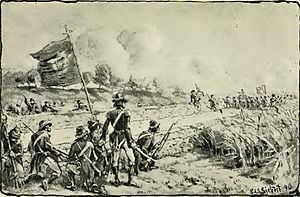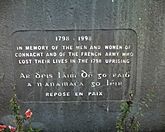Battle of Killala facts for kids
Quick facts for kids Battle of Killala |
|||||||
|---|---|---|---|---|---|---|---|
| Part of the United Irishmen Rebellion | |||||||
 Battle of Killala by Edward Seibert |
|||||||
|
|||||||
| Belligerents | |||||||
| Commanders and leaders | |||||||
| Eyre Power Trench | |||||||
| Strength | |||||||
| 900–4,000 Irish, 4 French officers |
1,200 | ||||||
| Casualties and losses | |||||||
| 400–500 dead | ? | ||||||
The Battle of Killala was an important fight during the Irish Rebellion of 1798. It happened on Sunday, September 23, 1798. The battle was fought in Killala, County Mayo, Ireland. It was between the British Crown forces and a group of Irish rebels, along with a few French soldiers. The British forces won this battle.
What Happened Before the Battle?
The day before the battle, government troops led by General Eyre Power Trench were on their way to Killala. People could see their advance from far away. This was because they were burning houses and cabins along their path.
Before the battle started, many rebels and people seeking safety came into Killala. They especially came from the direction of Ballina. The morning of the battle was very rainy. However, the rain stopped before noon. Only four French officers were with the rebels. Their names were Charoust, Boudet, Ponson, and Truc. Truc had just arrived that morning from Ballina.
The Battle Begins
The main group of rebels took a strong position. They were on high ground about a mile outside Killala. This spot was on the road leading to Ballina. They used low stone walls on both sides of the road for protection. These walls acted like small forts. Other rebels were placed in different spots near the town. They correctly guessed that General Trench would split his army to attack.
The government forces came towards the town in two groups. Each group approached from a different direction. One of these groups went towards where the rebels were waiting on the Ballina road. A fierce fight started when the two sides met. This part of the battle lasted for about twenty minutes. Then, the rebels had to fall back into the town.
Government troops chased the rebels as they retreated. Because of this chase, many rebels were hurt or captured. This happened both inside the town and in the fields around it.
After the Battle
The defeat at Killala was the last big land battle of the Irish Rebellion 1798. Killala had been controlled by the rebels for only thirty-two days. After the battle, government forces searched the town and nearby areas. They captured rebels and took them away. They also looked for houses that might have helped the rebels. Some people who were loyal to the Crown were also affected during these searches.
The four French officers were captured during the battle. They were sent to Dublin, and then to London. An Irishman named Henry O'Keane was an officer in the French Revolutionary Army. He was sent to Castlebar instead. There, he faced a special military trial called a court-martial. O'Keane was not sentenced to death. Instead, he was sent away from Ireland and told he could never return to any land controlled by the British Crown.
Military trials for captured rebels started the day after the battle. These trials took place in a house in Killala. It belonged to a local person named Owen Morrisson. Two rebel leaders, Richard Bourke and Captain Bellew, had their trials on Monday evening. They were found guilty. They were taken away the next morning in the park behind the town castle. Another important rebel leader, Roger MacGuire, was sent far away to Botany Bay. His father was also captured.
These trials and captures of other rebels continued for a week. In total, seventy-five prisoners had trials at Killala. The local Bishop of Killala and Achonry, Joseph Stock, wrote the most detailed story of the battle. He saw it happen himself. His account was published in the year 1800.
Sources of Information
- Gordon, James B. History of the Rebellion in Ireland in the year 1798, &c. London, 1803.
- Stock, Joeseph. A Narrative of what passed at Killalla, in the County of Mayo, and the parts adjacent, during the French invasion in the summer of 1798. Dublin & London, 1800.


